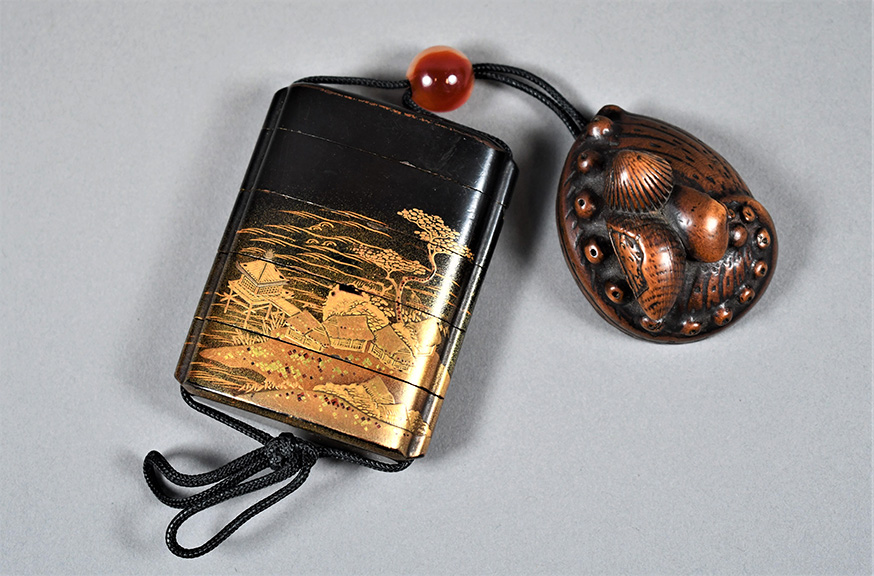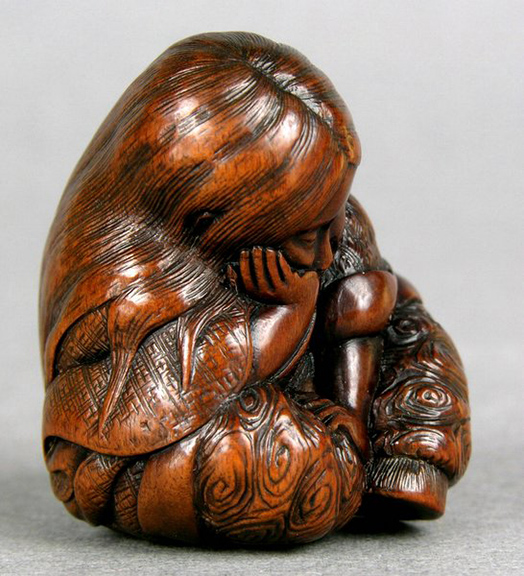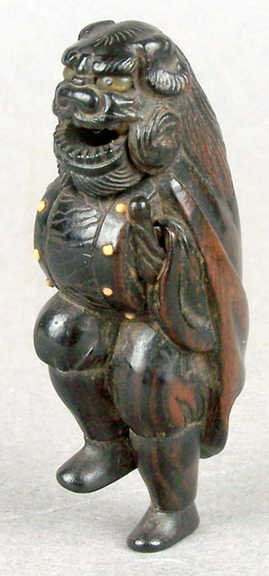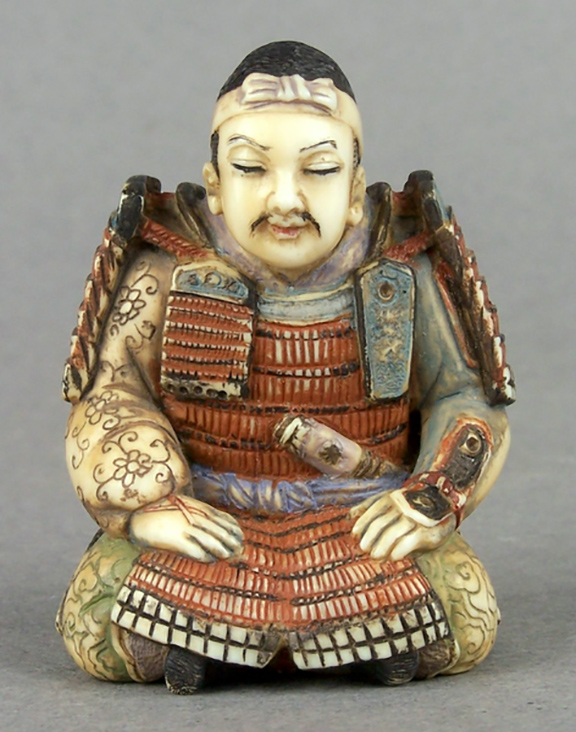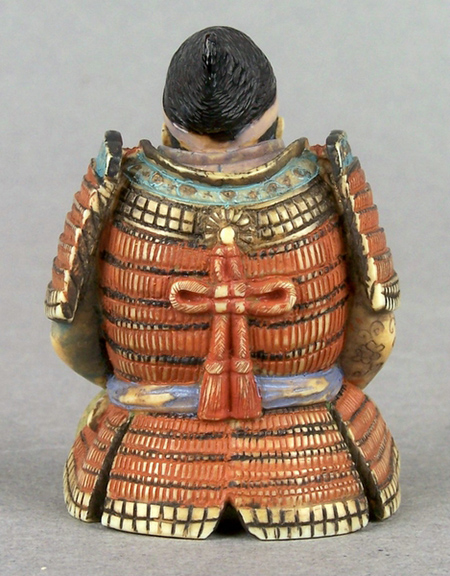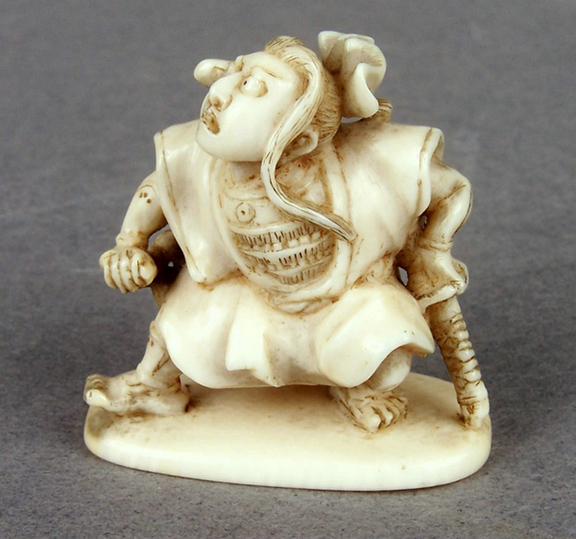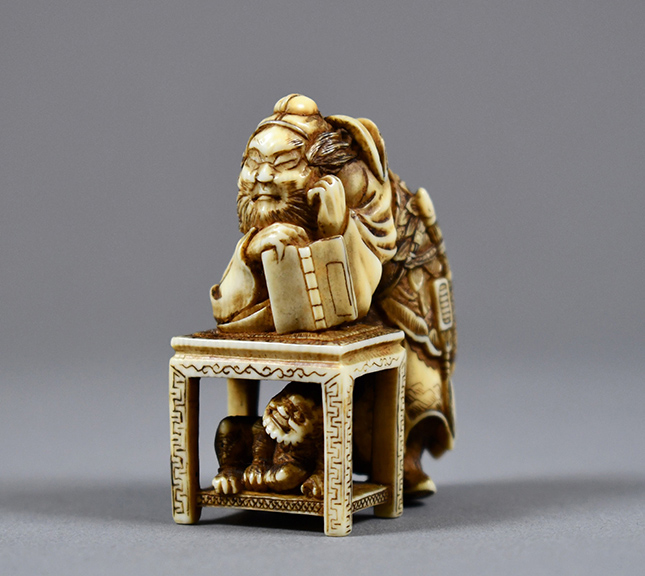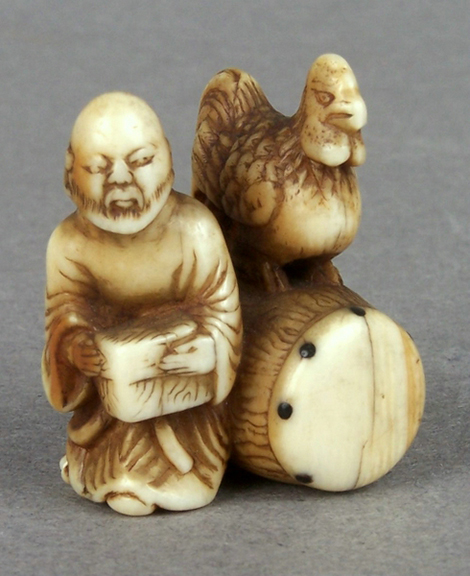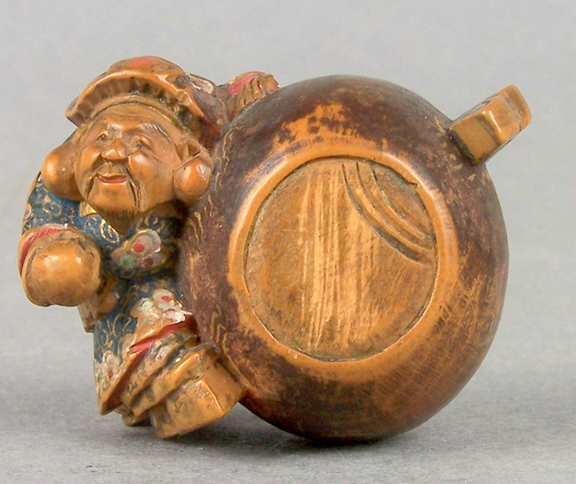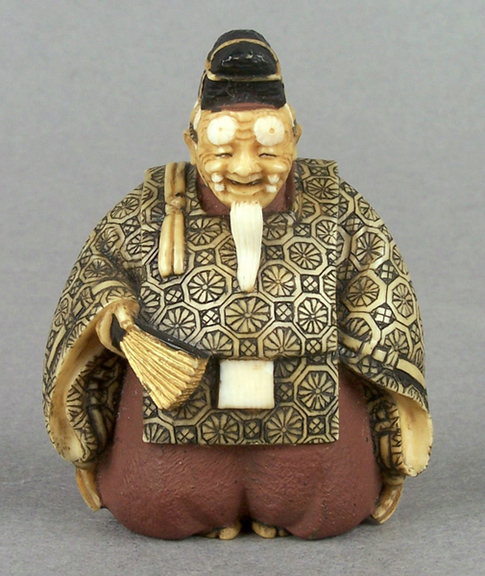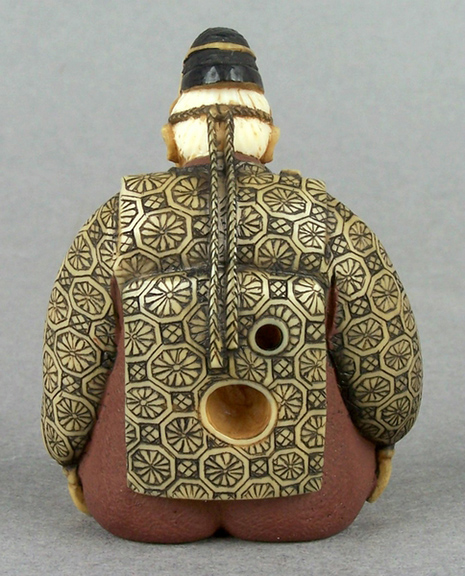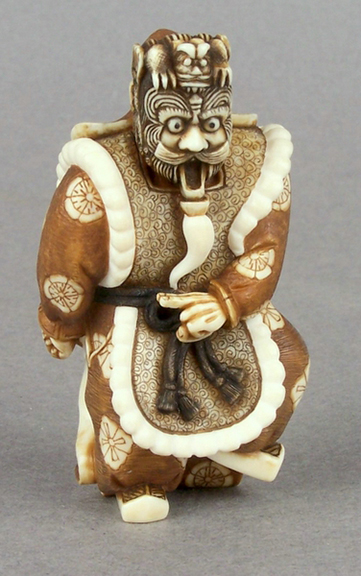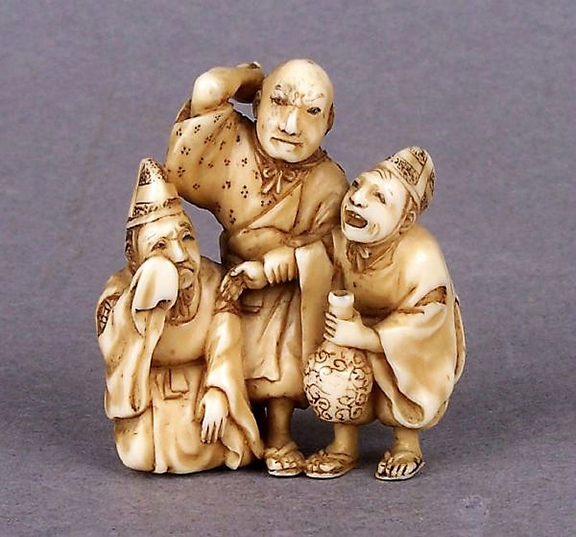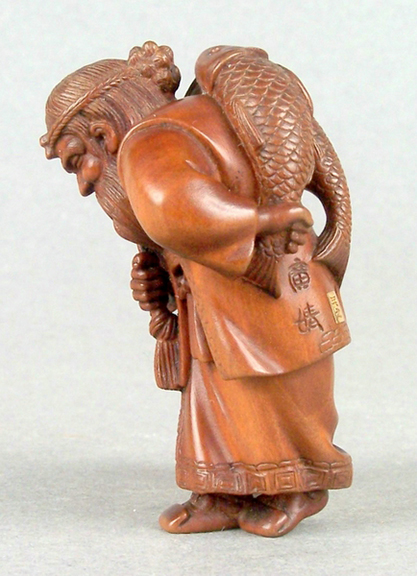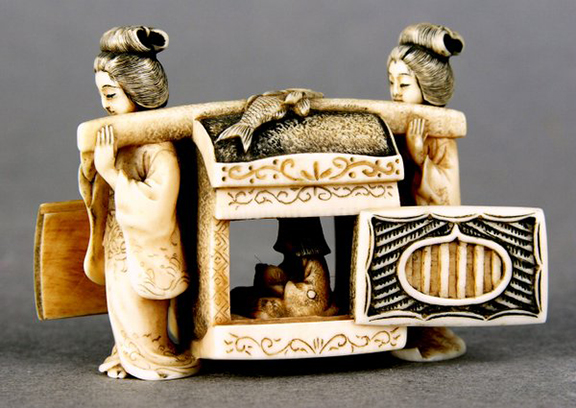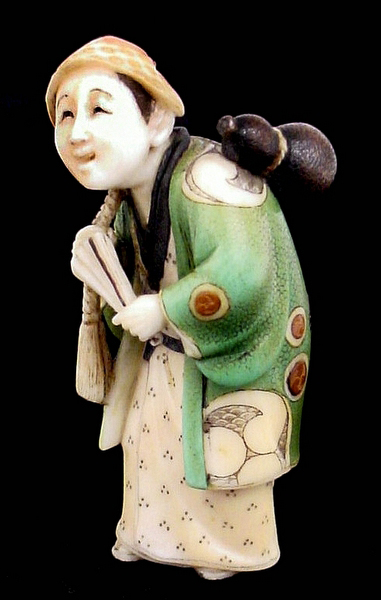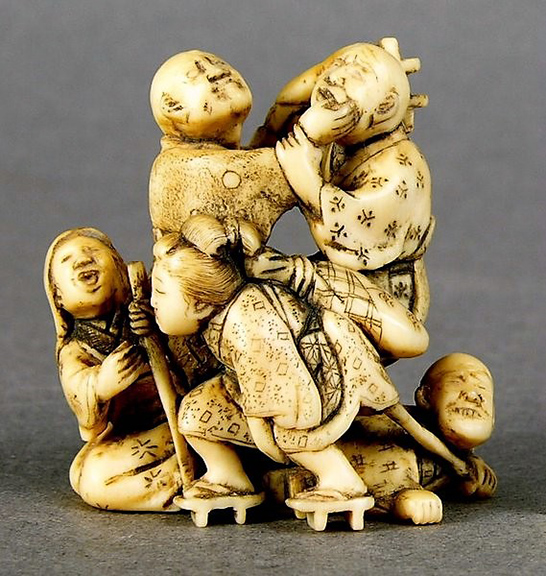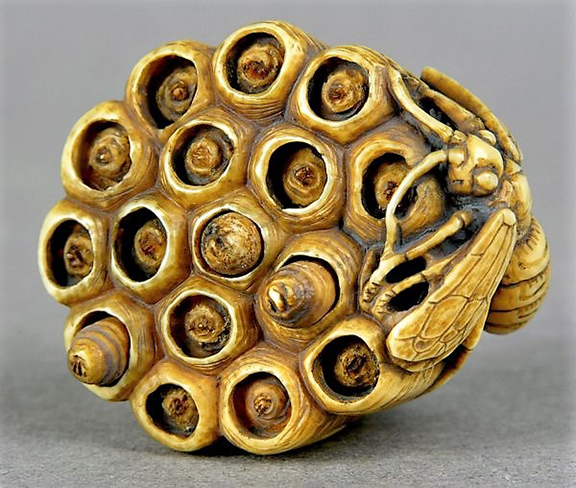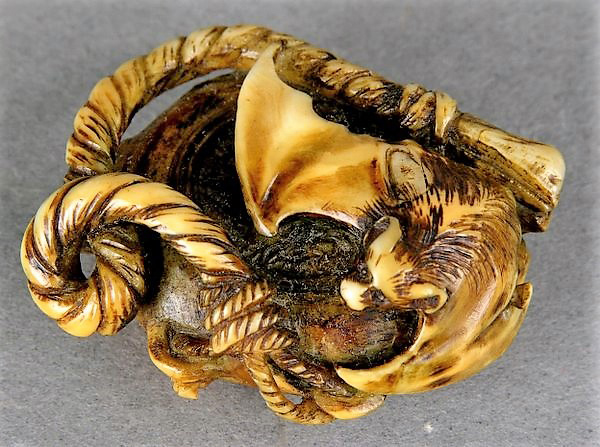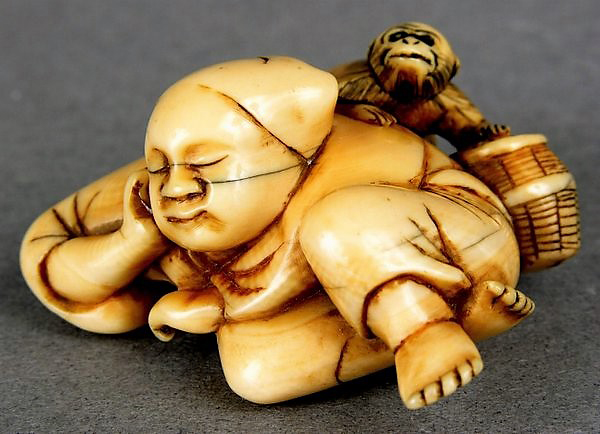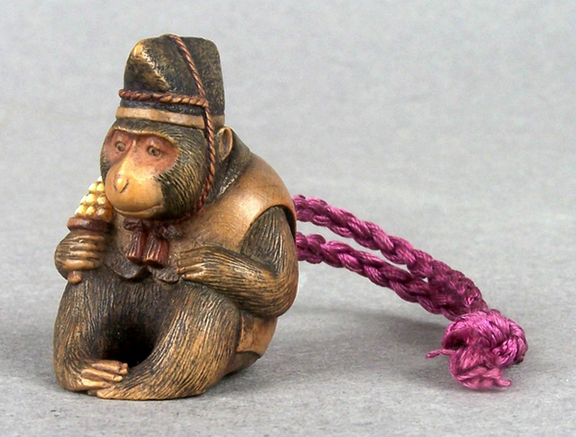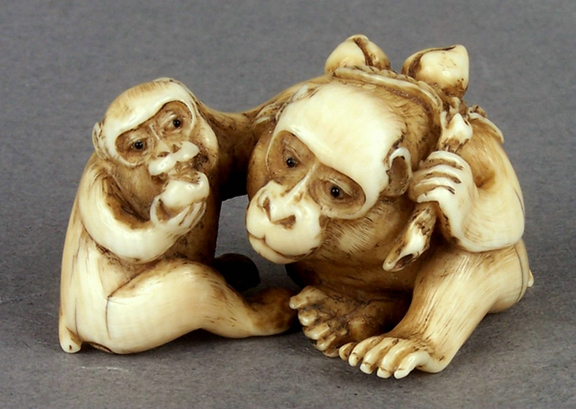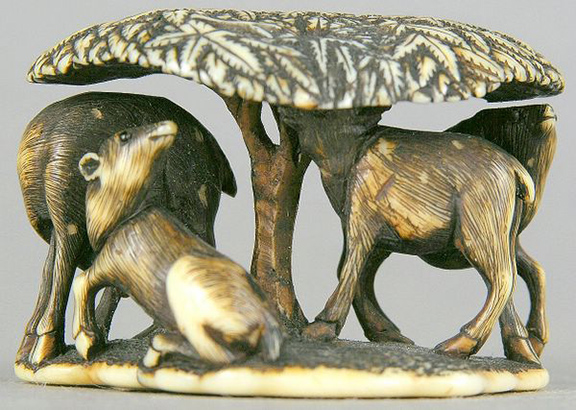Netsuke — The Devil is in the Details
One of the most intriguing Japanese fashion accessories is the inrō, or seal case. Because Japanese jackets and robes do not have pockets, artists created small cases for personal items such as seals, cosmetics, or tobacco to hang off the obi (sash). By the 17th century, inrō became increasingly elaborate. Carvers added more compartments and broadened the repertoire of subjects and themes. This allowed the wearer to transform a common utilitarian item into a highly personalized accessory. Inrō consist of three main parts: the container, a bead called the ojime (literally “cord-fastener”), and the toggle called a netsuke. From the late 19th to early 20th centuries, many Japanese people shifted to wearing Western style clothing and the demand for inrō diminished, however fine art collectors overseas helped to support the netsuke carving industry well into the 21st century.
Five-compartment medicine case (inrō),
19th c., late Edo or early Meiji period,
lacquered wood and stone,
2.5” h x 2” w,
ift of Arthur I. Fox,
2001.005.014a-g
Netsuke
Much like today with our own ever-changing trends surrounding our cellphones and their accessories, netsuke are miniature sculptures (generally less than 3” high) that can be carved into infinite themes and subjects to reflect the wearer’s own personal tastes. Some netsuke are shaped in 3D as animals or people; they can be round (manjū), long and thin, or even have moving parts. Regardless of the shape, netsuke carvers compose very compact and precise designs full of incredible detail. Popular themes range from the mythic and historic to religious subjects, everyday items, and even humorous objects. They come in a wide variety of materials, too.
Netsuke depicting a sea spirit (shōjō),
signed Masakazu,
ca. 1850-1870, late Edo period,
boxwood,
1.75” h x 1.125” w,
Gift of the Max Lonner Collection,
2004.019.191
Materials
Most netsuke are carved from ivory, wood, or bamboo with inlays such as shell, coral, or gold highlighting certain details, and pigmented lacquer to add color. More specifically the wood can be boxwood, cherry, or ebony. As Japan is an island nation, it is no surprise that many of the items used to produce netsuke are harvested from the ocean: various types of shell, especially abalone; marine ivory from whale teeth, walrus, or narwhal tusks; and umimatsu or, ‘sea-pine’ (also called Korean pine), which is actually a type of coral. Other rare materials like sharkskin, tortoise shell, jade, and the mineral cinnabar are sometimes used. Various types of mammal bone, antler, and elephant ivory are more common materials however, since 1989, federal and international restrictions on the trade and transport of ivory have limited antique netsuke sales and reduced their overall value somewhat – although they remain highly sought after items by fine art collectors around the world.
Lion dancer (shishimai),
signed Mitsumoto,
ca. 1810-1830, Edo period,
ebony wood with horn, umimatsu (sea pine or Korean pine), and ivory inlays,
2.125” h x .75” w,
Gift of the Max Lonner Collection,
2004.019.113
Coins,
signed Teruyuki,
ca. 1850-1870, late Edo period,
ivory,
.5” h x 2.25” w,
Gift of the Max Lonner Collection,
2004.019.0067
Legends
The Morikami Museum Collection of netsuke includes motifs of historic legends and mythic characters. One example is the legendary warrior Minamoto Yoshitsune (1159-1189), who played a pivotal role during the transition from the late Heian (794-1185) period – with its focus on life at the imperial court – to the early Kamakura period (1185-1333) and the rise of warrior- rulers. Yoshitsune is depicted throughout traditional and popular culture in woodblock prints, Kabuki plays, TV shows, and manga, and so we also find his persona represented in netsuke form, too. We can find examples of Yoshitsune’s faithful sidekick, a monk called Benkei. Together these two figures extoll the values of samurai valor and loyalty.
Minamoto Yoshitsune,
by Hiraga Meigyokusai (1896-1990),
ca. 1966-1989, Shōwa period,
pigmented ivory,
1.75” h x 1.25” w,
Gift of the Max Lonner Collection,
2004.019.061a-c
Possibly the monk Benkei,
signed Chiku’unsai,
ca. 1800-1868, Edo period,
ivory,
1.25” h x 1.25” w,
Gift of Max Lonner Collection,
2004.019.139
Blending Cultures
Many of the mythic characters depicted in the Collection were introduced to Japan from China, such as Shōki the Demon Queller. Shōki (Zhong Kui in Chinese) is revered as a god of scholarship for his great devotion to his studies of medicine, and as a protector against disease and evil spirits. He is often associated with the annual Boy’s Day celebrations held on May 5th. Sennin, or Daoist Immortals, were also imported from China. Typically there are eight Sennin portrayed together. The netsuke pictured of a bearded man and rooster is probably Kanshōshi (Han Xiang Zi in Chinese). While he is usually portrayed holding a flute, he is also known to carry a basket of peaches that will make humans immortal and has the ability to sooth wild animals. The drum and rooster next to him are symbols typically associated with Amaterasu, the Shintō Sun Goddess; so this is a blending of native Japanese and imported symbolism.
Shōki the Demon Queller,
ca. 1868-1899; Meiji, Taishō, or Shōwa period;
ivory,
2” h x .875” w,
Gift of the Max Lonner Collection,
2004.019.115
Sennin (Daoist immortal),
ca. 1770-1790,
Edo period,
ivory,
1.25” h x 1” w,
Gift of the Max Lonner Collection,
2004.019.080
There are also Seven Gods of Good Fortune borrowed by Japanese artists from Chinese lore. One of the most prominent in Japan is Daikoku. He is easily recognized by the large mallet he carries, in order to open bails of rice. He symbolizes abundance and is often seen in painting or sculptural forms in restaurants or near farm fields, and at New Year’s observances. A companion of Daikoku is Fukurokujin. Fukurokujin’s name is comprised of the characters for ‘blessings,’ ‘wealth,’ and ‘longevity.’ His elongated forehead makes him readily identifiable. Once again, we find two figures introduced from China, Daikoku and Fukurokujin, connected with something uniquely Japanese – the sport of sumo. Through these netsuke we can begin to perceive the highly syncretic nature of Japanese culture.
Daikoku with large mallet,
attributed to Nagamachi Shuzan II,
ca. 1800-1850, late Edo period,
lacquered wood,
1.25” h x 1.5” w,
Gift of the Max Lonner Collection,
2004.019.077
Daikoku and Fukurokujin sumo wrestling,
signed Gyokko,
ca. 1945-1950, Shōwa period,
ivory, 2” h x 1.5” w,
Gift of the Max Lonner Collection,
2004.019.121
Performers
Theatrical figures are also carved into netsuke. Old Man, or Okina, is an important character in the Noh theater repertoire. The Okina costume stems from formal court rites performed in the 7th and 8th centuries. Another type of traditional performance is gagaku, or formal court dances. One of the most iconic dances is Ranryō. The solo dancing figure was a great military commander in China known for hiding his good looks beneath a fierce mask in battle. Another type of formal dance that evolved from Noh into Kabuki is called, Sambasō. The tall, bell-shaped hats that the dancers wear make them easy to spot. A netsuke illustrating a monk reprimanding two drunken Sambasō dancers highlights the humor indicative of native Japanese art.
Noh character Old Man (Okina),
by Fujita Hozan (b. 1921),
ca. 1950-1989, late Shōwa period,
pigmented ivory,
2.5” h x 1.625” w,
Gift of the Max Lonner Collection,
2004.019.130a-c
Ranryō dancer,
by Sakurai Hideyuki (b. 1941),
ca. 1950-2000, Shōwa or Heisei period,
pigmented ivory, 2.25” h x 1.125” w,
Gift of the Max Lonner Collection,
2004.019.055a-c
Drunken Sambasō dancers and a monk,
by Ikkosai Toun (1804-1876),
ca. 1820-1876, late Edo or early Meiji period,
ivory, 1.5” h x 1.25” w,
Gift of the Max Lonner Collection,
2004.019.143
Everyday People
In addition to famous and grand figures, many other folks and everyday objects serve as inspiration to netsuke carvers. One example in the Collection is of an Ainu fisherman. The Ainu are one of the indigenous groups of Japan. They speak a different language, practice a different religion, and wear different clothing than the majority Japanese population. The robe with its ornate embroidery around the bottom edge and the full, bushy beard are typical of Ainu representations in the visual arts. The netsuke with a noble lady being carried in a palanquin by two other ladies has moving parts; the doors of the palanquin slide open and closed. A traveler with a drinking gourd would have been a common site in the Edo period (1603-1868). Yet another netsuke in the Collection illustrates five quarrelling travelers (two women and three men) tangled together. Their contorted faces and awkward positions, again, reveal the characteristic of Japanese artists to make fun of our shared human condition. The carver’s care and dedication are evident when you look beneath and see they have maintained the detail throughout, even in the tiny soles of the sandals and hands.
Ainu fisherman,
by Sakurai Hideyuki (b. 1941),
ca. 1950-2000, Shōwa or Heisei period,
boxwood,
2” h x 1.25” w,
Gift of the Max Lonner Collection,
2004.019.015
Women and palanquin,
by Minosuke Omura (b. 1912),
ca. 1930-1989, Shōwa period,
ivory, 1.375” h x 1.625” w,
Gift of the Max Lonner Collection,
2004.019.210
Traveler with drinking gourd,
signed Yasutaka, 19th c.,
late Edo to Meiji period,
pigmented ivory,
2” h x 1” w,
Gift of Arthur I. Fox,
2001.005.009
Five blind travelers,
by Ikkosai Toun (1804-1876),
ca. 1830-1843, Edo period,
ivory,
1.5” h x 1.25” w,
Gift of the Max Lonner Collection,
2004.019.224
Animals & Objects
Insects, animals, and inanimate objects are other categories of netsuke subject matter. Many insects that have an ‘ick’ factor in the West are highly prized and admired in the East. Wasps have been appreciated in Japan for a long time. There is even an annual festival in Kushihara, Gifu province, held each November where you can eat mochi (rice cakes) and drink sake made with wasp larvae! Similarly, the bat is a traditional symbol of good luck frequently found in paintings, textiles, ceramics, and other genres. The bat netsuke in the Collection is resting on a gong similar to the ones found at Buddhist temples and Shintō shrines, which adds a religious connotation.
There are fine representations of various animals in the collection as well. There are several monkeys, which are one of the 12 zodiac animals. The first netsuke pictured comically depicts a sleeping monkey trainer (sarumawashi) with his charge looking wide awake as he attempts to open a basket of goodies. Notice the bell-shaped hat on the second monkey pictured, indicating he is a Sambasō dancer. Thirdly, we have a pair of monkeys eating persimmons, yet another common motif in both painting and sculpture. Deer also carry religious overtones as they are considered messengers of the gods. Legend has it that a Shintō deity rode a white deer into the city of Nara thousands of years ago. The Sika deer still roam the Tōdai-ji temple grounds freely today as protected animals. The chestnut, on the other hand, is perceived as a symbol of luxury or satisfaction in Japan. Roasted chestnuts can be purchased from cart stalls throughout Japan in autumn.
Wasps’ nest,
by Hiraga Meigyokusai (1896-1990),
ca. 1966-1989, Shōwa period,
ivory,
1.5” h x 1.25” w,
Gift of the Max Lonner Collection,
2004.019.220
Bat,
ca. 1850-1870, late Edo period,
ivory,
.75” h x 1.5” w,
Gift of the Max Lonner Collection,
2004.019.202
Sleeping monkey trainer (sarumawashi),
Kyoto school,
ca. 1770-1790, Edo period,
ivory,
1” h x 2” w,
Gift of the Max Lonner Collection,
2004.019.200
Monkey dressed as Sambasō dancer,
by Inada Ichiro (b. 1891),
ca. 1931-1950, Shōwa period,
lacquered wood,
1.25” h x .875” w,
Gift of the Max Lonner Collection,
2004.019.027
Monkeys eating persimmons,
signed Gyokuzan,
ca. 1840-1860, late Edo period,
ivory with umimatsu (sea pine or Korean pine),
1” h x 1.75” w,
Gift of the Max Lonner Collection,
2004.019.033
Deer under a tree,
signed Masayuki,
20th c., Taishō or early Shōwa period,
ivory,
1” h x 1.75” w,
Gift of the Max Lonner Collection,
2004.019.226
Chestnuts and acorns,
signed Ryoshu,
1974, Shōwa period,
pigmented ivory,
.75” h x 1.5” w,
Gift of the Max Lonner Collection,
2004.019.207a-c
Personality
While we might think of Japan as having a homogenous society with individuals who are not interested in standing out from the group, we can see by the personal accessories worn in the medieval era – from the late 12th to the early 17th centuries – that a certain amount of individualism was valued and expressed via clothing and accessories. You might have noticed that most of the netsuke presented here come from one collector, Mr. Max Lonner. Not only are netsuke personalized statements of the wearer, but also the collectors of today as they can demonstrate their own interests and inclinations in a highly refined and personal way.
